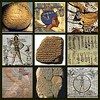Christians and BDSM

- Bondage (B)
- Bondage & Discipline (B&D)
- Domination & Submission (D&S)
- Sadism & Masochism (or Sadomasochism) (S&M, SM)
When does BDSM become religious?
In the Roman Empire, flagellation was often used as a prelude to crucifixion, and in this context is sometimes referred to as scourging. Whips with small pieces of metal or bone at the tips were commonly used. Such a device was easily able to cause disfigurement and serious trauma, such as ripping pieces of flesh from the body or loss of an eye. In addition to causing severe pain, the victim would be made to approach a state of hypovolemic shock, due to loss of blood.
Flagellation is the act of whipping (Latin flagellum, "whip") the human body. Specialised implements for it include rods, switches, and the cat-o-nine-tails.
Flagellantism was a 13th and 14th century Christian movement. It began as a militant pilgrimage. The followers were noted for including public flagellation in their rituals.
Flagellants are practitioners of an extreme form of mortification of their own flesh by whipping it with various instruments.
The practice of mortification of the flesh for religious purposes includes the Christian Flagellant movements of the 13th century, and the present-day members of Opus Dei.
Mortification of the flesh literally means "putting the flesh to death". The term is primarily used in religious contexts, and is practiced in a variety of ways. The institutional and traditional terminology of this practice in Catholicism is corporal mortification.
Frankly I am not surprised about the sexual nature of religious devotion. I think neurologists would testify that there is a "fine line between pleasure and pain." (Which is quite a long time before Christina Amphlett and The Divinyls sang about it.)

Christina Amphlett
One only has to look back at some of the christian worshippers in the previous centuries who beat themselves with cat of nine tails to show their supplication to the lord to realise that they were seeking pleasure through pain. In fact, flagellation or mortification of the flesh, was seen to be "pain which was to be loved relative to the positive end."
Through pain came redemption, therefore pain was to be embraced and to be enjoyed. Certainly that seems like sado-masochistic tendencies to me. For example, a contemporary saint, Josemaria Escriva said, while consoling a dying lady who was suffering in the hospital, "Blessed be pain! Glorified be pain! Sanctified be pain!"
Pain was seen as an integral part of human nature. And pain united the worhipper to Jesus through the pain that Jesus also suffered. So pain was to be embraced and enjoyed, the more pain, the closer one was to the Christ. (I can't begin to tell you how freaky this sounds to me though I know to a lot of believers this seems so wonderful.)
Deliberate pain inflicted for religious reasons which is seen as pleasurable will remain in the "oh, how weird basket" for me. Though these historical accounts do begin to explain the confusion people have had between what is painful and what is pleasurable. But to seek pain and call it pleasure and to believe that that pain will in some way make the person more worthy of the love of a god, still seems quite psychologically disturbing to me.
Divinyls - Pleasure & Pain (1985)



















1 Comments:
For a long time, I've considered religion to be a masochistic activity. But, I never knew BDSM was a literal part of some historical Christian traditions. Very interesting post. I think you've hit upon a curious connection between these two seemingly disparate worlds.
Post a Comment
<< Home